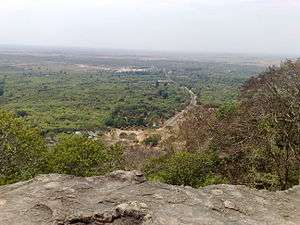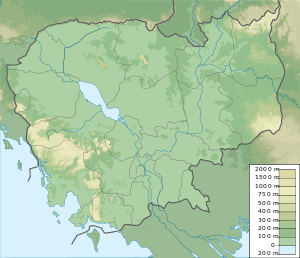Phnom Santuk
Phnom Santuk (Khmer: ភ្នំសន្ទុក) is a hill and cultural site in the Cambodian province of Kampong Thom. Located in Ko Koh village, Ko Koh commune, Santuk District, it is the most sacred mountain of the province. The summit is accessed by a stone pathway with many statues flanking the way. At the top is a white-walled temple and many shrines and deities, including several reclining Buddhas made out of rock,[1] measuring more than 33 feet (10 m) in length.[2] Monks inhabit the site.
| Phnom Santuk | |
|---|---|
 View of the valley below Mount Phnom Santuk | |
| Highest point | |
| Elevation | 207 m (679 ft) |
| Coordinates | 12°38′N 105°00′E |
| Geography | |
 Phnom Santuk Location of Mount Phnom Santuk | |
| Location | Santuk, Kampong Thom, Cambodia |
Geography
Phnom Santuk is a hill of 679 feet (207 m) elevation, which rises above the Tonlé Sap river valley. The summit can be reached either by climbing 809 steps,[2] or via a paved road, 2.5 kilometres (1.6 mi) in length.[1] Vistas of Tonlé Sap valley can be observed from the peak, with sunset views over the rice fields considered to be a major tourist attraction.[3] Phnom Srah Kmao, located next to Phnom Tantuk, contains a brick temple and bat cave.[4]
Features
There are many Buddha images and pagodas enshrined along the way to the peak. New wats in prasat style are under construction near the hilltop. Nagas (serpent figures) and dragons are carved in profusion on these wats. Below the southern peak, at the base of the trees, there are many reclining Buddhas, some carved in rock in the earlier times and a few others are made of concrete in recent times. The multi-storied Chinese pagoda has a number of figurines made in porcelain.[1] A panirvana sculpture, carved in rock of Buddha of the Theravada Buddhism period, dates to the sixteenth century. It is similar to the one found carved on a boulder in Prea Ang Thong, and is also seen in the holy hill of Phnom Santuk.[5] Nature-based tourism is available at the Phnom Santuk Resort.[6]
Culture
The protector deity of the mountain is known as Neak ta Kraham Ka, who lived during the feudal period of Kompong Thong, under the feudal ruler Decho Borara’a Thipadei Meas. Phnom Santuk is a pilgrimage site.[5] Worship is offered in the wats on the hill and there are seven monks who perform this service; Preah Thamma Vipassana Kong served as chief monk in the late 18th century.
History
During the Cambodian Civil War, Phnom Santuk marked the furthest advance into the north-east by the US-backed Khmer Republic's forces, in September 1971 during the Operation Chenla II offensive.
References
- Cambodia. Lonely Planet. p. 286. GGKEY:ALKFLS6LY8Y. Retrieved 1 January 2013.
- DK Travel Guides (1 June 2011). DK Eyewitness Travel Guide: Cambodia & Laos. Dorling Kindersley Limited. p. 99. ISBN 978-1-4053-4985-7.CS1 maint: ref=harv (link)
- "Lonely Planet review for Phnom Santuk". Lonely Planet. Retrieved 2 December 2012.
- Bhuaṅ, Kaev (2004). Tourism sites of Cambodia. Ponleu Khmer. p. 84. Retrieved 4 January 2013.
- Ian Harris (1 March 2008). Cambodian Buddhism: History and Practice. University of Hawaii Press. pp. 2, 44, 62, 211–. ISBN 978-0-8248-3298-8. Retrieved 1 January 2013.
- Wood, Timothy Dylan (2009). Tracing the Last Breath: Movements in Anlong Veng. ProQuest. pp. 96–. ISBN 978-1-109-21799-5. Retrieved 4 January 2013.
External links
| Wikimedia Commons has media related to Phnom Santuk. |